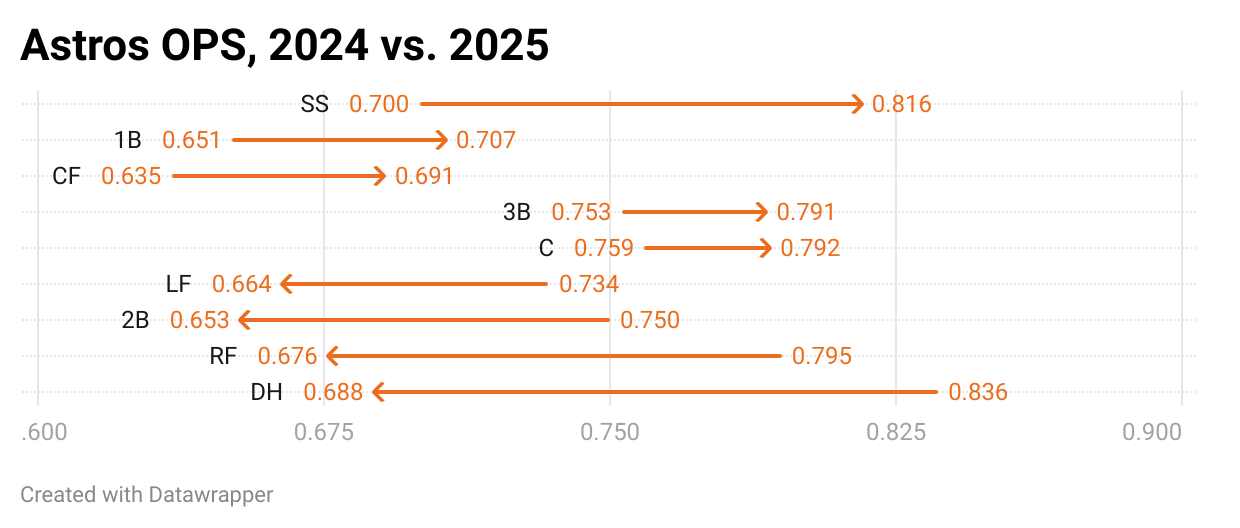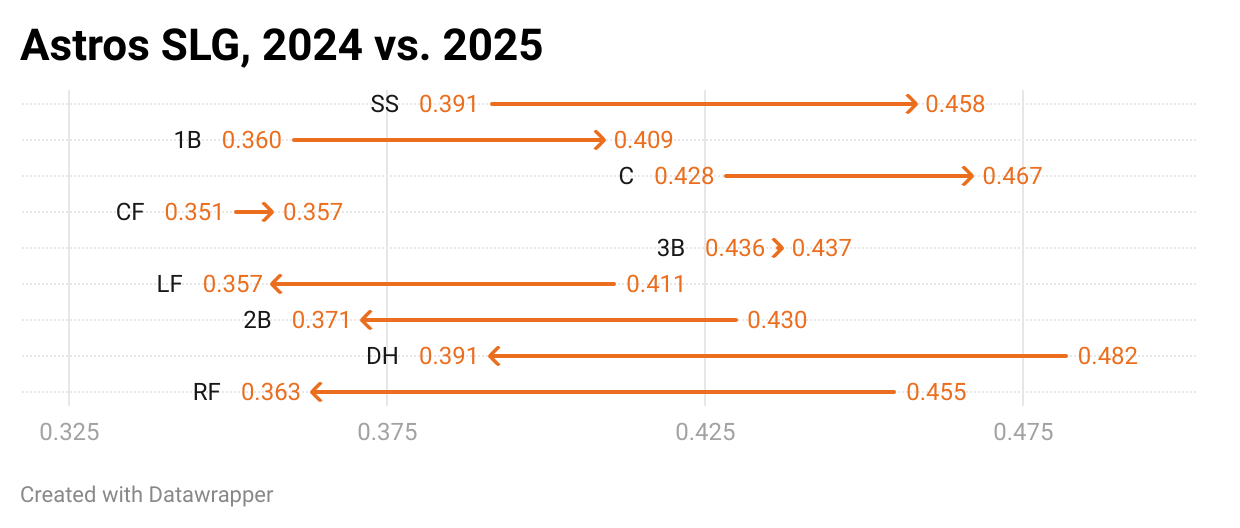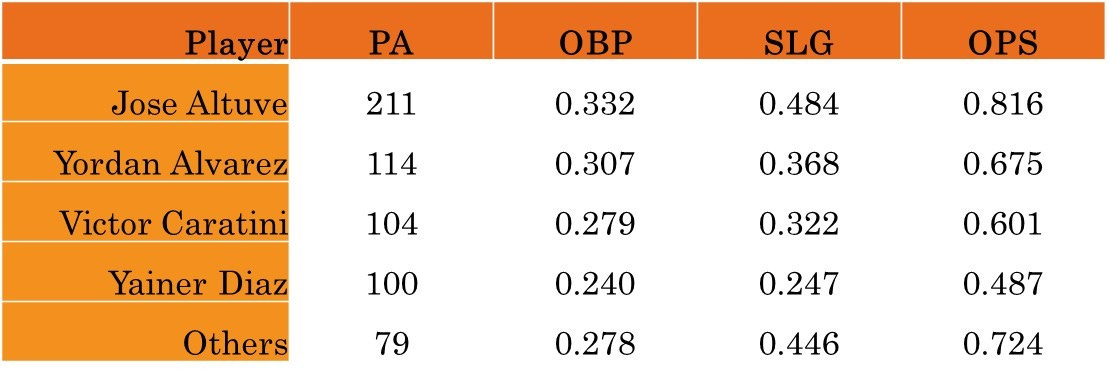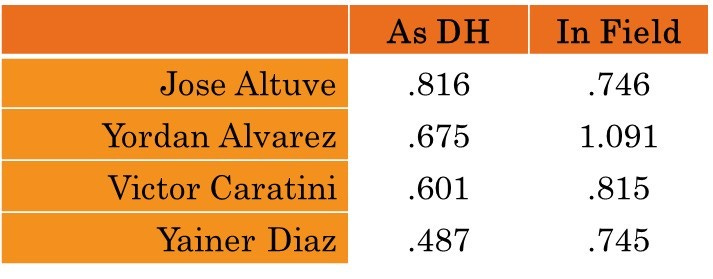What is the source of the Astros offensive decline? A very large DH penalty
Players usually hit worse as a DH than when they play the field. Alvarez, Caratini, and Diaz all have huge DH penalties this season. Though surprisingly, Altuve is hitter better as a DH.
The Astros won 90 games in 2023 and 88 games in 2024. They are on pace for 88 wins again this season. Same season, once again?
Well, not quite. As I detailed recently, we have seen a big decline from the offense this season. In 2024, the Astros scored 4.60 runs per game, which was 10th best in the majors. This season, the Astros are scoring 4.23 runs per game, which is 25th best. Or to put it another way, the Astros offense is between the Angels and the White Sox in run scoring.
It’s not the place where you want to be.
Where is the decline of the Astros offense coming from? To examine that question, I took a look at the Astros offensive output this season compared to 2024 by position. So this counts Mauricio Dubon’s starts when he plays second base different from when he plays left field, or center field, or any of his other positions.
The chart below compares the Astros OPS across the two seasons. There’s actual good news here, as the Astros have increased their OPS at five positions—shortstop, first base, center field, third base, and (surprisingly) at catcher.
Much of this makes sense. Jeremy Pena and Jake Meyers have had breakout years. The first base situation was a disaster in 2024, and has improved to meh. Isaac Paredes and Carlos Correa have taken up the slack created by Alex Bregman’s departure at third base.
But the four positions where the team has declined have been big declines. Left field has not gone well this season. Second base took a step back as Altuve has played less there and Brendan Rodgers more.
The decline in right field is easy to explain. Kyle Tucker is not there. It was obvious place the team was going to take a step back this season going from an All-Star to a player barely out of college.
The remarkable decline has been at designated hitter. In 2024, it was the team’s best offensive position. Astros DHs had an OPS of .836. This year, they have an OPS for .688. For context, major league baseball as a whole this season has an OPS or .721. That’s right, at the most offense-first position in baseball, the Astros are getting a below average offensive performance.
I did the same chart for slugging percentage. You can see pretty similar results. The numbers go up at the same 5 positions—the increase in center field is more modest and it’s barely an increase at third base.
Again, the decreases are only at 4 positions, but they are quite big. There is a significant decline in left field and second base. The largest decline is the shift from Kyle Tucker to Cam Smith in right field.
But quite notable is the decline at DH. It was the team’s biggest power position in 2024. This year’s DH’s have a .391 slugging percentage, below the league number or .405.
Here’s a GIF with my comment on the DH performance this season.
What is going on at designated hitter this season? The basic answer is that the player the Astros are putting at DH are not performing well. I put the Astros numbers at DH in the table below.
Yordan Alvarez is supposed to be one of the best hitters of his generation. But he has slumped when on the field this season, likely because he was hobbled by a hand injury even before he was placed on the IL.1 Victor Caratini is performing poorly at DH. And Yainer Diaz is just an absolute disaster at DH.
The Astros have some good slugging numbers from the 10 players who have rotated through the DH spot for days off of their feet or as late inning replacements. But their on base percentage is quite low.
There is one exception to the poor performance at DH. Jose Altuve is doing very well when he is the DH, with an .816 OPS. He’s Jose Altuve. Of course he can hit.
But there is another part of Altuve’s performance as DH that is distinct. This table shows the OPS for the 4 main Astros DH’s this season when they are the DH compared to when they are in the field.
Alvarez, Caratini, and Diaz are all above average hitters when they get to play in the field. And they are much worse at the plate when they do not have to play in the field.
Altuve is the exception here, as his OPS is 70 points higher as the DH than when he plays in the field.
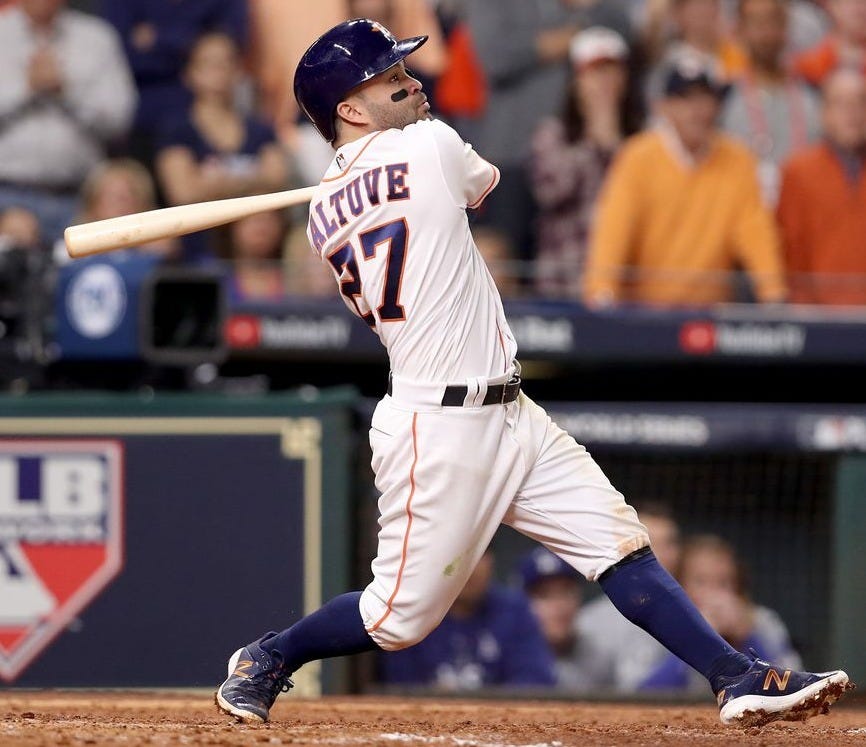
And in general, Altuve is the exception. In general, there is “penalty” for being the DH. In The Book: Playing the Percentages in Baseball, Mitchell Lichtman, Andy Dolphin, and Tom Tango found that the batters perform significantly worse when they play a game as DH than when they play a fielding position. The penalty for the average DH is 17 points of wOBA. To put that into context, that’s about 5% worse than average.
Why does this penalty exist? Lichtman wrote on his blog that “the most likely explanation for this is that the DH is not as physically (and perhaps mentally) prepared for each PA as a player who is constantly engaged in the game. As well, the DH may be slightly injured or tired, especially if he is normally a position player.”
This speculates that players who are usually in the field are out of routine when they are the DH. And baseball players, seemingly more so than even other athletes, are creatures of routine. Perhaps Victor Caratini is less mentally engaged on days when he serves at the DH than on days when he is the catcher, working through each plate appearance on defense with his pitcher.
Another reason that DH performance might be worse is that players get DH days when they are tired after having played many days in a row. So it’s possible that Yainer Diaz is getting being asked to DH on his “day off” from catching, which is needed because he is worn down from catching.
Regardless of the reason, it’s notable and surprising that Jose Altuve is able to overcome that this season. He has done this through his career. Over his 15 seasons in the majors, Altuve has an .832 OPS as a second baseman and only a .765 OPS as a DH. So he has the traditional DH penalty.
But, up until this season, Altuve has played very little DH. Before this season, he had only played in 42 games and had 178 PAs as a DH. Perhaps he is adjusting to a new role. And perhaps it is an effect of small sample sizes. We will see in the future.
What is clear is that the Astros other 3 main DH’s this season—Alvarez, Caratini, and Diaz—are suffering from very large DH penalties. All three are hitting significantly worse at designated hitters than they are when they are playing in the field.
And that is making an outsized contribution to the Astros declining offense this season.
That his hitting has returned to Yordanian standards after his return from the IL supports the conjecture that he was playing injured in the Spring.


